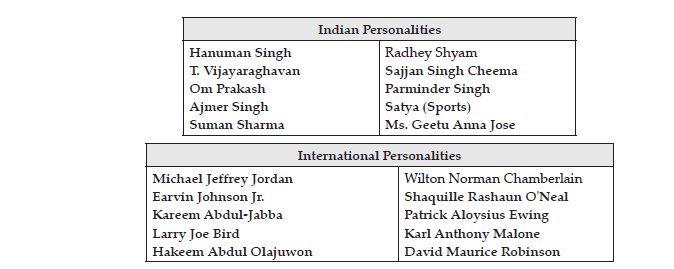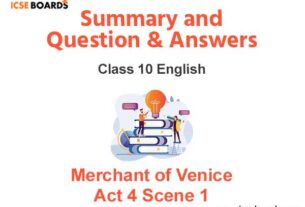Please refer to Physical Education Class 10 ICSE Basketball notes provided below. These revision notes have been prepared based on the latest syllabus and examination pattern for ICSE Class 10 Physical Education issued for the current academic year. Students should always revise these revision notes prior to their exams to properly prepare and understand all topics. After reading these notes also refer to Sample Papers for Class 10 ICSE Physical Education
ICSE Class 10 Physical Education Basketball Revision Notes
Students can refer to the quick revision notes prepared for Chapter Basketball in Class 10 ICSE. These notes will be really helpful for the students giving the Physical Education exam in ICSE Class 10. Our teachers have prepared these concept notes based on the latest ICSE syllabus and ICSE books issued for the current academic year. Please refer to Chapter wise notes for ICSE Class 10 Physical Education provided on our website.
Physical Education Class 10 ICSE Basketball Notes
➢ Introduction :
Basketball is played by 2 teams of 5 players each. The aim of each team is to score in the opponents’ basket and to prevent the other team from scoring. The game is controlled by the officials, table officials and a commissioner, if present. The basket that is attacked by a team is the opponents’ basket and the basket which is defended by a team is their own basket. The team that has scored the greater number of points at the end of playing time shall be the winner.
➢ World History
The game of Basketball was first invented by Dr. James Naismith of USA in December, 1891 at Spring Field College, United States of America. In the very beginning, 40 to 50 players used to be in one team. The game used to be played in a Gymnasium. A pair of baskets was nailed on the walls facing each other. One had to take the ball out whenever a goal was scored. After that, Dr. Smith framed certain rules of the game.
➢ Indian History
Approximately 85 years ago in India, the game of Basketball was introduced by Y.M.C.A College, Madras. Since then, Basketball has become popular in every part of India. The Indian Basketball Federation was formed in 1950.
➢ Governing Bodies of Basketball
FIBA
International Basketball Federation (Federation International de Basketball)
FIBA, the International Basketball Federation, is the world governing body for basketball, founded in 1932.. FIBA brings together 214 National Basketball Federations from all over the world. FIBA organises and oversees international competitions. FIBA establishes the official basketball rules as well as the regulations that govern the relationships between the different members of the basketball communities.
BFI
Basketball Federation of India
The Basketball Federation of India (BFI), which came into being in 1950, is the governing and controlling body of basketball in India, responsible for the development and promotion of the sport at all levels. BFI oversees all the national level basketball operations in India.
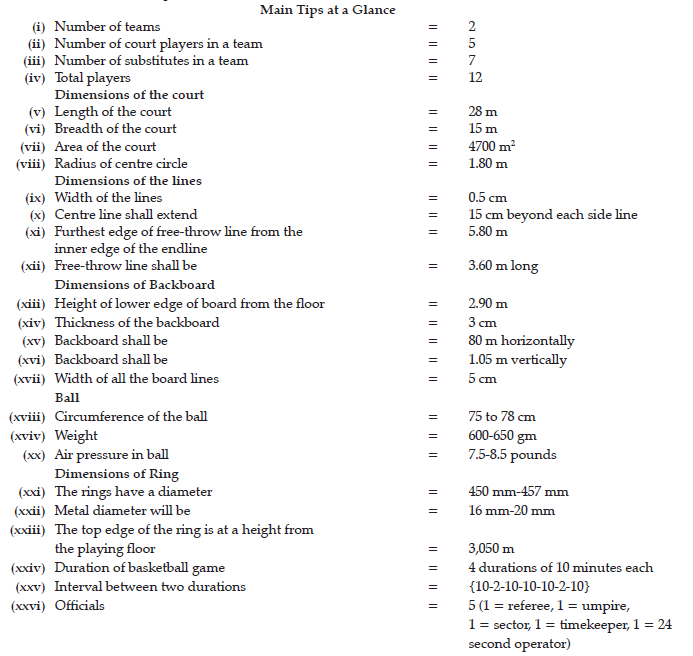
➢ Fundamental Skills of Basketball
(i) Handling the ball
(ii) Passing
(a) Chest or push pass
(b) Baseball pass
(c) Underhand pass
(d) Overhead pass
(e) Two handed bounce pass
(f) Hook pass
(g) Flip pass
(h) Tip or volley pass
(i) Back pass
(iii) Pivoting
(iv) Dribbling
(a) High dribble
(b) Low dribble
(v) Shooting
(a) Two hand shot
(b) Lay up shot
(c) Hook shot
(d) Jump shot
(vi) Rebounding
(vii) Defence
(viii) Dodge
(a) To dodge with singles
(b) By speed
(c) By escape
(ix) Free throw
(x) Offensive strategy
(a) Faking
(b) Screening
(c) Triangular attack
(d) Zonal attack
(xi) Defensive attack
(a) Blocking
(b) Tackling
(c) Zonal defence
(d) Guarding
(e) Man to man defence
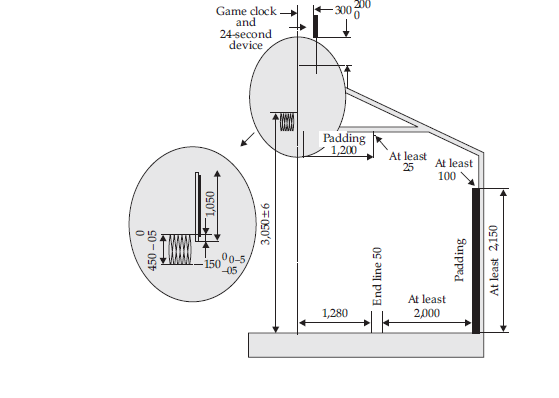
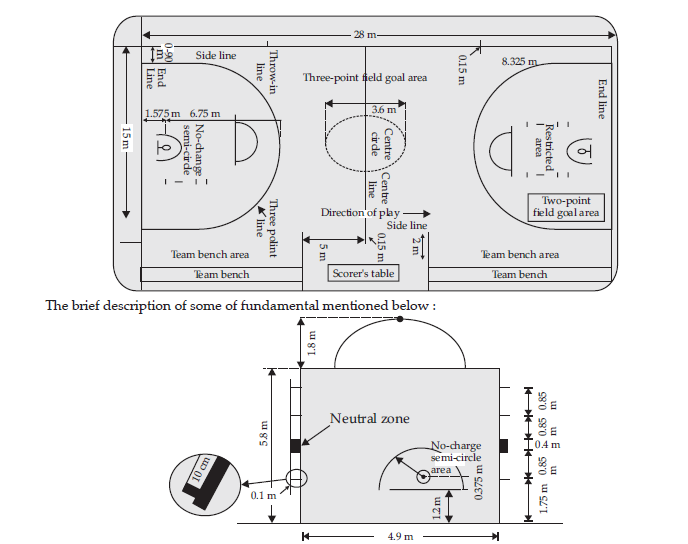
➢ Dribbling
A dribble is the movement of a live ball caused by a player in control of that ball who throws, taps, rolls the ball on the floor or deliberately throws it against the backboard. It is of two kinds :
(i) High dribbling : The objective in high dribbling is to advance the ball more quickly. It is always meant for advancing the ball; here bounce is comparatively higher up to waist level.
(ii) Low dribbling : It is used when the offensive in the ball is being guarded closely. Low dribble is controlled dribble. The ball is protected while putting the body between ball and the defensive player.
➢ Pivoting
It is a very important skill because it helps basketball player to attack or defend himself and his position. A pivot takes place when a player who is holding the ball steps once or more than once in any direction, with the same foot, while the other foot called the pivot foot is being kept at its point of contact with the floor.
➢ Shooting
In order to score points in basketball, you need to shoot the ball into the hoop. This requires the ability to properly hold and throw the ball into the air towards the basket while avoiding defenders. There are three kinds of shoo- ting :
(i) Jump shot : A jump shot or jumper is an attempt to score a basket by jumping, usually straight up, and in mid-jump, propelling the ball in an arc into the basket.
(ii) Lay-up shot : A shot in which a player reaches the ring by taking one and a half step.
(iii) Dunk shot : A shot is called the Dunk shot when a player jumps high enough to get the ball up and over the ring to press it forcefully into the ring.
➢ Catching
Catching the ball is just an action that requires your hands placing a grip on the ball. The sole purpose is to receive the ball from another player.
➢ Passing
Passing means the movement of the ball from one player to another. Passing is the best way to keep possession of the basketball and is a faster way of moving the ball up the court than dribbling. A good pass is smoothly handled and not forced. It is usually 12-18 feet (the longer ones can be easily intercepted) and is made with control.
(i) Chest pass : This technique is used when there is no defender standing in the way between the passer and his intended receiver. The ball is gripped with both hands by placing the fingertips on both sides of the ball; the thumbs should nearly meet behind the ball..
(ii) Bounce pass : In bounce pass, the holding of the ball, body positions and passing action is approximately the same as in two hand chest pass.
(a) One-handed bounce pass : One-handed bounce pass is used when the bounce pass is difficult for defender to steal. The change of direction is hard for the defender to judge.
(b) Two-handed bounce pass : Two-handed bounce pass is used to avoid a defender who is trying to block or intercept the ball.
(iii) Overhead pass : This technique is often used to break a defensive trap. The idea is for the passer to get the ball to a receiver who is tall and who is standing close to the basket.
(iv) Baseball passing : In this type of pass, the ball should be taken just behind the head on right or left direction with a support of the upper portion of palm and fingers. One foot should be kept in front of the other and the ball should be thrown with a swing of the fingers. This pass is usually applied for long passes.
➢ Ball handling
Ball is held with both hands firmly. The fingers should spread evenly on the ball. The angle of thumb is to be at 40 degrees facing angularly to each other. Relax the shoulders and elbows close to the body.
➢ Jumping
Jumping is another skill that can define how good a basketball player is. Jumping is involved in offense during the jump ball in the beginning, while taking shots and sometimes while trying to catch a pass.
➢ Rebounding
It means successfully gaining possession of the ball after a missed field goal or free throw. Power forwards and centres do most of the rebounding for their team as they should be two tallest players in the team.
➢ Blocking
When a player attempts to screen and block the opponent in restricting the move towards scoring.
➢ General Rules of Basketball
Although there are rules variations between men, and women’s basketball and between the various levels of play, there are basic rules that govern play at any level.
(i) Only five players can play in each team at one time.
(ii) Any number of substitutions may be made during any dead ball.
(iii) Substitute must wait by the scorer ’s table until called into the play by an official.
(iv) Any player may request a time out.
(v) A goal is scored when the ball passes through the basket from the above.
(vi) Two points are scored for a goal from the court other than from the three point’s area.
(vii) Each successful free throw awarded for fouls scores one point.
(viii) If the players put the ball into the basket of the opponent, a goal is scored.
(ix) A goal is stopped when an official indicates a handball.
(x) The ball is put into the play at the beginning of the game by a jump ball into a centre circle by two opposing teams.
(xi) A players is out of bounds when he touches the floor on or outside of the boundary lines.
(xii) The ball is out of bounds when it touches the person or thing that is on or outside the boundary of or the supports or back of the backboards.
(xiii) A team is awarded a throw-in at the place where opposing team causes the ball out-of- bounds.
(xiv) An offensive player may not remain in the free throw lane (the area between the endline, free throw line, and free throw lines) for more than 3 seconds during play.
➢ Equipment Needed to Conduct the Basketball Match
The following equipment will be required:
(i) Backstop units, consisting of:
(a) Backboards
(b) Baskets comprising (pressure release) rings and nets
(c) Backboard support structures including padding
(ii) Basketballs
(iii) Game clock
(iv) Scoreboard
(v) Shot clock
(vi) Stopwatch or suitable (visible) device (not the game clock) for timing time-outs
(vii) 2 separate, distinctly different and loud signals, one each for the
(a) Shot clock operator,
(b) Scorer /timer.
(viii) Score sheet
(ix) Player foul markers
(x) Team foul markers
(xi) Alternating possession arrow
(xii) Playing floor
(xiii) Playing court
(xiv) Adequate lighting
➢ Terminology Related to Basketball
(i) Blocking out : When a player positions himself or herself under the backboard in such a way that it prevents the opposition from achieving good rebounding position.
(ii) Cut : Quick offensive maneuver by a player in order to get in position to receive a pass.
(iii) Dodging : Pretending to move or throw the ball in one direction but actually moving or throwing the ball in a different direction.
(iv) Double foul : Two opposite players commit fouls against each other at the same time.
(v) Dribble : Continuously bouncing the ball onto the floor without touching the ball with both hands at the same time, allowing the ball to stop its continuous movement, or losing control.
(vi) Fake (Feint) : Use of deceptive move to pull the opposing player out of position.
(vii) Fast break : Moving quickly into defensive position before the defensive team has an opportunity to set up.
(viii) Free throw : A penalty shot awarded to a player where the opposition has committed a foul.
(ix) Held ball : A situation in which opposing players both hold the ball, neither of them can get possession; this is resolved by the referee by throwing the ball in the air between them.
(x) Jump ball : Method of putting the ball into play that involves tossing the ball up into the air between two opposing players in the centre circle.
(xi) Multiple foul : A foul on an opponent by two or more players at the same time.
(xii) Outlet pass : Direct pass from a rebound that starts a fast break.
(xiii) Rebound : Term used for the action of the ball as it bounces off the backboard or ring.
(xiv) Screen : Offensive player gets in position between a defender and a teammate in order to give the defender an uncosted shot at the basket.
(xv) Set shot : An unhindered shot taken from a well balanced position is called a set shot.
(xvi) Technical foul : A non contact foul by a player, team or coach for unsportsman like behaviour or failure to follow the rules and regulation.
(xvii) Throw in : Putting the ball into play from out of bounds.
(xviii)Travelling : Player in possession of the ball moves illegally in any direction.
➢ Main Fouls
(i) Personal foul : A personal foul is that foul when a player involves contact, blocks and catches, an opponent.
(ii) Intentional foul : It is a personal foul which is committed intentionally by a player.
(iii) Double foul : A double foul is that when two opponents commit foul against each other almost at the same time.
(iv) Multiple foul : A foul on an opponent by two or more players at the same time.
(v) Technical foul : A non contact foul by a player, team or coach for unsportsman like behaviour or failure to follow the rules and regulation
(vi) Five foul : If a player commits five fouls either personal or technical, he or she shall be turned out for whole match.
➢ Main Rules to Understand
(i) Three seconds rules : A player shall not remain in the opponents’ restricted area for more than three consecutive seconds while his team is in control of a live ball in the frontcourt and the game clock is running.
(ii) Five seconds rules : According to the new rules, when a closely guarded player, who is holding the ball, does not pass, shoot, roll or dribble the ball within five seconds, it shall be considered a violation with a side line throw for the opponents.
(iii) Eight seconds rules : After the attacking team gains possession of the ball in their own half, they have eight seconds to move the ball into the opposition’s half otherwise they will lose the possession.
(iv) Twenty four seconds rules : A team shall attempt a shot within 30 seconds after taking control of the live ball.
(v) Travel rules : Travelling or progressing while holding the ball, moving either with one or both the feet, shall be considered out of bounds.
➢ Sports Award

➢ Tournaments and Venues
International Tournaments Men’s tournaments
(i) Men Basketball at Olympics
(ii) FIBA World Championship
(iii) Euro Basket
(iv) FIBA American Championship
(v) FIBA Asia Championship
(vi) FIBA Africa Championship
➢ Women’s tournaments
(i) Women Basketball at Olympics
(ii) FIBA World Championship
(iii) Euro Basket
(iv) FIBA American Championship
(v) FIBA Asia Championship
(vi) FIBA Africa Championship
➢ National tournaments
(i) Federation Cup
(ii) Senior National Championship
(iii) Junior National Championship
(iv) Youth National Championship
(v) Sub- Junior National Championship
(vi) All- India Ramu Memorial Trophy
(vii) (c) Munni Swami Cup
(viii) (b) C Gupta Trophy
➢ Sports Personalities
